Mollymawk
The mollymawks are a group of medium-sized albatrosses that form the genus Thalassarche. The name has sometimes been used for the genus Phoebetria as well, but these are usually called sooty albatrosses. They are restricted to the Southern Hemisphere, where they are the most common of the albatrosses. They were long considered to be in the same genus as the great albatrosses, Diomedea, but a study of their mitochondrial DNA showed that they are a monophyletic taxon related to the sooty albatrosses, and they were placed in their own genus.[1]
| Mollymawk | |
|---|---|
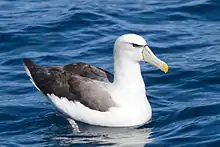 | |
| Shy albatross (Thalassarche cauta) | |
| Scientific classification | |
| Kingdom: | Animalia |
| Phylum: | Chordata |
| Class: | Aves |
| Order: | Procellariiformes |
| Family: | Diomedeidae |
| Genus: | Thalassarche L. Reichenbach, 1853 |
| Species | |
|
Thalassarche chlororhynchos | |
| Synonyms | |
|
Diomedea (partim) | |
Etymology
The word mollymawk, which dates to the late 17th century, comes from the Dutch mallemok, which means mal – foolish and mok – gull.[2] Another etymology suggests that it comes from the German Mallemugge, a term used originally for midges or flies that whirled about lights.[3]
Taxonomy
Mollymawks are a type of albatross that belong to the family Diomedeidae of the order Procellariiformes, along with shearwaters, fulmars, storm-petrels, and diving-petrels. They share certain identifying features. First, they have nasal passages that attach to the upper bill called naricorns, although the nostrils are on the sides of the bill. The bills of Procellariiformes are also unique in that they are split into between seven and nine horny plates. They also have a salt gland that is situated above the nasal passage and helps desalinate their bodies, due to the high amount of ocean water that they imbibe. It excretes a high saline solution from their nose.[4] Finally, they produce a stomach oil made up of wax esters and triglycerides that is stored in the proventriculus. This can be sprayed out of their mouths as a defence against predators as well as an energy rich food source for chicks and for the adults during their long flights.[5] The fossil species Thalassarche thyridata known from a skull fragment from the Late Miocene of Victoria, Australia shows that the genus had already diverged from the sooty albatrosses 10 mya.[1]
Extant Species
| Image | Scientific name | Common name | Distribution |
|---|---|---|---|
 | Thalassarche chlororhynchos | Atlantic yellow-nosed albatross | mid-Atlantic, including Tristan da Cunha (Inaccessible Island, Middle Island, Nightingale Island, Stoltenhoff Island) and Gough Island. |
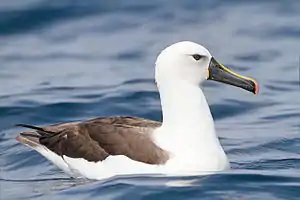 | Thalassarche carteri | Indian yellow-nosed albatross | Prince Edward Islands, the Crozet Islands, Kerguelen Island, Amsterdam Island (on the Falaises d'Entrecasteaux) and St Paul Islands in the Indian Ocean, from South Africa to the Pacific Ocean just beyond New Zealand |
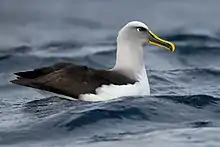 | Thalassarche bulleri | Buller's albatross | New Zealand |
 | Thalassarche cauta | shy albatross | Australia and Tasmania, in the southern Indian Ocean |
.jpg.webp) | Thalassarche steadi | white-capped albatross | New Zealand |
.jpg.webp) | Thalassarche eremita | Chatham albatross | Chatham Islands |
 | Thalassarche salvini | Salvin's albatross | Southern Ocean, Île des Pingouins in the Crozet Islands in the Indian Ocean |
 | Thalassarche impavida | Campbell albatross | South Island and the Chatham Rise to the Ross Sea. |
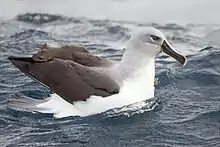 | Thalassarche chrysostoma | grey-headed albatross | South Georgia in the South Atlantic, and smaller colonies on Islas Diego Ramírez, Kerguelen Islands, Crozet Islands, Marion Island, and Prince Edward Islands in the Indian Ocean, Campbell Island and Macquarie Island south of New Zealand, and Chile. |
 | Thalassarche melanophrys | black-browed albatross | Atlantic Ocean, it breeds on the Falkland Islands, South Georgia and the South Sandwich Islands, and the Cape Horn Islands. |
Fossils
- †Thalassarche thyridata
Description
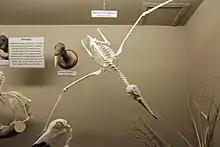
Mollymawks have the largest range in size of all the albatross genera, as their wingspans are 180 to 256 cm (71–101 in).[6] Mollymawks have what has been described as gull-like plumage, with dark black backs, mantle and tails and lighter heads, underwings and bellies. The heads of several species are often slightly darker grey, or have dark around the eyes. They all have a colourful pinkish flesh stripe from their gape to their ear that is shown during displays. They have distinctive bill structure and colouring which makes for easier identifying than other albatrosses.[6] The bills of mollymawks are either brightly coloured orange or yellow, or dark with several bright yellow lines.
See also
References
- Nunn, Gary B.; Cooper, John; Jouventin, Pierre; Robertson, Chris J. R. & Robertson Graham G. (1996). "Evolutionary relationships among extant albatrosses (Procellariiformes: Diomedeidae) established from complete cytochrome-b gene sequences" (PDF). Auk. 113 (4): 784–801. doi:10.2307/4088857. JSTOR 4088857.
- "Mollymawk". Oxford Dictionaries. Oxford University Press. Retrieved 28 June 2015.
- Newton, Alfred (1896). A dictionary of birds. London: Adam and Charles Black. p. 530.
- Ehrlich, Paul R.; Dobkin, David, S.; Wheye, Darryl (1988). The Birders Handbook (First ed.). New York, NY: Simon & Schuster. pp. 29–31. ISBN 0-671-65989-8.
- Double, M. C. (2003). "Procellariiformes (Tubenosed Seabirds)". In Hutchins, Michael; Jackson, Jerome A.; Bock, Walter J.; Olendorf, Donna (eds.). Grzimek's Animal Life Encyclopedia. 8 Birds I Tinamous and Ratites to Hoatzins. Joseph E. Trumpey, Chief Scientific Illustrator (2nd ed.). Farmington Hills, MI: Gale Group. pp. 107–111. ISBN 0-7876-5784-0.
- Robertson, C. J. R. (2003). "Albatrosses (Diomedeidae)". In Hutchins, Michael; Jackson, Jerome A.; Bock, Walter J.; Olendorf, Donna (eds.). Grzimek's Animal Life Encyclopedia. 8 Birds I Tinamous and Ratites to Hoatzins. Joseph E. Trumpey, Chief Scientific Illustrator (2nd ed.). Farmington Hills, MI: Gale Group. p. 114. ISBN 0-7876-5784-0.
Further reading
- ITIS (2007). "ITIS Standard Report Page: Thalassarche". Integrated Taxonomic Information System. Retrieved 19 Feb 2009.
External links
 Media related to Thalassarche at Wikimedia Commons
Media related to Thalassarche at Wikimedia Commons Data related to Thalassarche at Wikispecies
Data related to Thalassarche at Wikispecies
